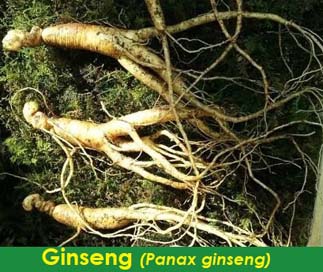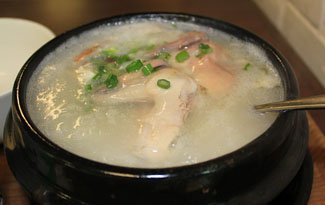Ginseng Nutrition facts
Popular as "ren shen" (man root, 人参) in the mainland China, ginseng is the epitome of strength and well-being, trusted by many since ancient times. The root and other plant parts have been in use to stimulate metabolism, treat conditions such as mental stress, fatigue, blood sugar control, improve health, and enhance disease-free long life.
Botanically, this medicinal root plant belongs to the Araliaceae family of flowering plants in the genus: Panax. Its two main species: Asian ginseng (Panax ginseng C.A. Meyer) and its close relative, American ginseng (Panax quinquefolium L.) considered the true cultivar types of this rhizome. All other types, including the Siberian ginseng (Eleutherococcus senticosus), are labeled as pseudo ginseng.
 |
Ginseng is a perennial, temperate, flowering herb native to the Northeastern woodlands of China and Manchuria. Both Asian and American ginsengs grow best in well-drained, sandy loam soils and woody shadow coverings.
Panax ginseng produces small, light green-white flowers and red berries. Flowering begins in the 2nd or 3rd year and lasts for 2 to 3 weeks in each season from June until September. However, under the cultivated farms, farmers do pruning in order to facilitate bigger root growth. Its rhizome is harvested by pulling the whole plant, as in carrots, after about 6 years of seedling when the berries begin to ripen.
The roots are then washed in clean water, segregated according to their size, and processed to obtain either white ginseng or red ginseng.
Health benefits of Ginseng (人参)
All the products of the ginseng plant including its rhizome prized in the Chinese, Korean, and Japanese culture since ancient times. Many believe that consuming root extraction and products of ginseng would confer them stamina, endurance to overcome hardships, and good health.
Since it is consumed in such small quantities, ginseng root does not add any calories and fats to the body. Nonetheless, it holds several health-promoting neuro-active substances, anti-oxidants, minerals, and vitamins.
The two most important active compounds in the ginseng are triterpene glycosides, or saponins, commonly referred to as ginsenosides: protopanaxadiol and protopanaxatriol.
The bioactive compounds in the rhizome can act as immune-modulator (Cho et al., 2002), anti-tumor (Yun et al., 1983), antioxidant, and glucose-lowering activities (Fitzenberger et al., 2014).
Furthermore, it also holds other chemical substances such as polyacetylene and phenolic compounds, such as maltol (Hwang et al., 2006), salicylic acid, vanillic acid, genistic acids, p-coumaric acid have been identified as principal phenolic antioxidants in ginseng (Jung et al., 2002).
Medicinal uses
Ginseng is chiefly employed as an adjuvant in traditional medicines in China, Japan, and Native Americans.
Chinese practitioners of alternative medicine believe that white ginseng is mild and not too warm in nature, suitable for general body type. Red Ginseng, on the other hand, is very warm in nature and hence, advised during the colder months.
In traditional Chinese medicine (TCM), ginseng is advocated as a sex stimulant. Ginsenosides compounds enhance the synthesis and release of nitric oxide (NO) in the genital blood vessels. Nitric oxide (NO) causes relaxation of blood capillaries and increases tissue cyclic GMP (guanosine monophosphate) levels in the genital tissues.
Studies have shown that ginsenosides improve overall general metabolic functions of the body, including enhanced liver functions and digestion. They also possess anti-inflammatory actions, anti-cancer, and immune-boosting properties.
The root is prescribed to treat colds and flu, stress, and as an adjuvant to treat some cancers and Type-2 diabetes.
Selection and storage
Raw, fresh rhizomes can only be available near the vicinity of growers during harvesting times. In the overseas markets, dry roots in vacuum packs, and powder can readily be found all around the year. White ginseng (Bái cān-白参) is produced by drying the just harvested root in the sun, while the red ginseng (hongs hen or Korean red ginseng) is steamed after harvest and then sun-dried.
In supermarkets, pharmacies, and specialist Traditional Chinese Medicinal (TCM) Stores, one may come across different kinds of ginseng products like tea, honey, drinks, candy, jelly, etc. Read the total ginsenosides content in the products before using these products.
At home, dried ginseng root can be stored for several months and preserved inside a dry jar, kept in a cool place away from sunlight and humidity. Its powder can be stored inside the refrigerator for a couple of months.
Preparation and serving methods
 |
| Samgye-tang (Korean red ginseng-chicken soup). Photo courtesy: asianfiercetiger |
Processed ginseng seldom requires any cleaning. Cut a small piece of the root (not more than 3 grams of dry weight at a time) and steep in a glass of hot water for about 2 minutes and drink.
Here are some serving tips:
Fresh root is steeped in hot water and mixed with honey and herbs enjoyed as a refreshing tea.
In Korea, the herb root is also used in the preparation of the famous summer recipe samgye-tang (ginseng-chicken-soup). It is usually served with kimchi and ginseng-wine (insamju).
The root extraction found a unique place in the food industry in the preparation of beverages, candies, gums, spicy snacks, candies, etc.
True facts about Ginseng
Ginseng and its products chiefly influence metabolic functions like digestion, circulation, and the central nervous system in the human body.
Ginseng should be viewed as an adaptive and restorative tonic. It is not a substitute for regular therapeutic medications for specific diseases.
The constituents in the root ginseng have structural and functional similarities to natural steroids. They affect the hypothalamus-pituitary-adrenal axis and the immune system, which could account for many of its reputed actions.
There are no well-documented studies to support its claim as an aphrodisiac agent.
The rhizome contains vitamins and minerals. However, in the dosage amounts, the herb rhizome barely covers the daily requirements of vitamins and minerals and therefore does not have much health impact.
Safety profile
Ginseng when taken in controlled doses for a short period of time has beneficial effects. Toxicity to glycosides occurs when consumed in larger amounts for prolonged periods. Some of the common symptoms of overdosage are rising blood pressure, lack of sleep (insomnia), anxiety, neuroses, etc.
It is also known to potentiate the toxicity of anti-coagulant drug warfarin, resulting in severe bleeding episodes. It impairs blood glucose levels in patients on anti-hypoglycemic drugs and insulin.
Pregnant women are generally advised to avoid it. (Medical disclaimer).
≻≻-Back to Herbs from Ginseng. Visit here for an impressive list of all varieties of herbs with complete illustrations of their nutrition facts and health benefits.
≻≻-Back to Home page.
Further Resources:
Phenolic compounds and antioxidant properties. (Links open in new window-pdf)